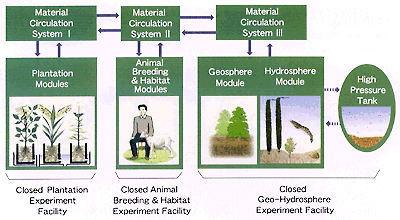 |
 |
 |
 |
 |
 |
|||||
 |
 |
 |
 |
| IT'S A SMALL WORLD: Biosphere Experiment to Begin Soon April 28, 2000  The Closed Ecology Experiment Facilities reproduce the earth's ecosystem in small scale. (Institute for Environmental Sciences) Construction of a "mini-earth" biosphere--a research station that recreates the earth's environment in an enclosed space--has been completed in Aomori Prefecture, on the northernmost tip of Honshu island. Full-scale research focusing on the natural cycle of materials will begin at the facility in April 2000. In the first such experiment in Japan, the biosphere will attempt to shed light on the relationship between the emission and absorption of carbon dioxide, which is the key to understanding global warming, and explore the potential use of such facilities in future space stations. About 10 years ago a similar experiment was launched in the United States; the fact that it ended in failure is all the more reason for the high hopes the Japanese experiment has been stirring up. Understanding the Cycle of Matter The biosphere is divided into three zones: a plantation section, where vegetables and grains are grown; an area to accommodate the humans who will eventually reside there as well as livestock that will supply them with vitamin-rich dairy produce; and a forest and marine area containing trees that will supply the facility with oxygen and a simulated ocean. The human and animal residents will feed on the vegetables and grains grown in the crop section, and their waste and the carbon dioxide they exhale will nourish the plants. The plants will absorb the carbon dioxide during photosynthesis, in turn producing oxygen and establishing a cycle of matter. The plantation zone has already yielded crops for over four years. In a greenhouse measuring about 70 square meters (753 square feet) grow such vegetables as sweet potatoes, leeks, cucumbers, and tomatoes. All the vegetables are bigger and have fatter leaves than those on sale in stores. Rice, the staple food for humans, is grown under artificial light; it develops much faster than naturally grown rice and is ready to harvest in just four months. People to Move In from 2005 The most important issue in such an enclosed environment is preserving the balance between oxygen and carbon dioxide in the atmosphere. Even the tiniest shift in that balance could lead to a fatal breakdown of the biosphere's delicate equilibrium. According to staff at the biosphere, a similar experiment was conducted in the Arizona desert in the United States from September 1991. Humans inhabited that research facility--named Biosphere 2--for two years. It was bigger than the Japanese biosphere, but the experiment ended in failure due to unexpected environmental factors: The concrete in the facility absorbed carbon dioxide, and microorganisms in the soil absorbed oxygen. Those involved with Japan's mini-earth intend to learn from the U.S. example and take great care in conducting the experiment, with the hope that the results of their biosphere project will have benefits for the future of the whole planet.  Copyright (c) 2000 Japan Information Network. Edited by Japan Echo Inc. based on domestic Japanese news sources. Articles presented here are offered for reference purposes and do not necessarily represent the policy or views of the Japanese Government. Copyright (c) 2000 Japan Information Network. Edited by Japan Echo Inc. based on domestic Japanese news sources. Articles presented here are offered for reference purposes and do not necessarily represent the policy or views of the Japanese Government.
|


